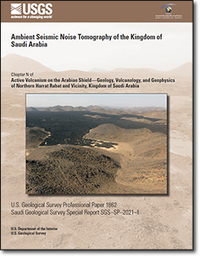Ambient Seismic Noise Tomography of the Kingdom of Saudi Arabia
Links
- Document: Report (10.9 MB pdf)
- Larger Work: This publication is Chapter N of Active volcanism on the Arabian Shield—Geology, volcanology, and geophysics of northern Harrat Rahat and vicinity, Kingdom of Saudi Arabia
- Download citation as: RIS | Dublin Core
Abstract
Harrat Rahat is a Cenozoic volcanic field in the west-central part of the Kingdom of Saudi Arabia, 150 kilometers east of the Red Sea, and is the site of the most recent eruption in the country (1256 C.E.; 654 in the year of the Hijra). The city of Al Madīnah lies at the north end of Harrat Rahat, and its volcanic and seismic risks are frequently reassessed. In 2009 C.E. an earthquake swarm at Harrat Lunayyir, 200 km west-northwest of Al Madīnah, produced significant shaking and some building damage in nearby communities, which prompted a revision of seismic hazard models for the region. A network of seismic stations on this volcanically active western side of the Arabia Plate was installed, and stations were also added in the tectonically active northern part of the country. Although regional earthquakes may be used to determine the crustal structure of the western Arabia Plate, such crustal models are hindered by insufficient numbers of earthquakes in the stable plate interior. Tomography studies can be used to infer material properties of the subsurface, such as presence of partial melt, and are beneficial for volcanic hazard assessments. We use ambient seismic noise to compute Rayleigh and Love surface-wave dispersion maps between 5 and 12 second periods for a subset of seismic stations within and near northern Harrat Rahat. The surface-wave maps are inverted to produce shear-wave velocities using a neighborhood algorithm and interpolated into a pseudo three-dimensional model. The distributions of surface-wave and shear-wave velocities are heterogenous, varying from ±3–8 percent. However, low velocities are not restricted to Harrat Rahat. We observed a difference between Rayleigh- and Love-wave velocities that extends north of the site of the 1256 C.E. eruption and coincides with a low gravity anomaly. We obtain a shear-wave velocity increase of 10–15 percent between 15- and 25-kilometers depth, which is consistent with the presence of a transition between the felsic upper crust and the mafic lower crust of the Arabian Shield. The average shear-wave velocities of the upper and lower crust are estimated to be 3.64 and 3.95 kilometers per second using Rayleigh waves and 3.53 and 4.16 kilometers per second using Love waves, which are in good agreement with the results of other geophysical surveys in this area. The modest magnitude of the low-velocity anomalies within the crust and their locations extending well beyond the limits of Harrat Rahat indicate that they are not caused by a crustal magma chamber. If magma chambers exist, they are smaller than can be imaged with our seismological method (resolution corresponds to a 15-kilometer wavelength), deeper than 30 kilometers, or shallower than 5 kilometers with a small velocity contrast. The last possibility is discounted by weak-to-absent surface geothermal activity and by a lack of shallow seismicity that characterizes other areas with known shallow magmas, such as Hawaiʻi. We then expanded our work to the entire Arabian Shield with principally the same methodology to look at large-scale regional patterns. We found modest shear-wave velocity deviations on the order of only ±3 percent, which are within expected ranges for lithological variation.
Suggested Citation
Civilini, F., Mooney, W.D., Savage, M.K., and Townend, J., 2023, Ambient seismic noise tomography of the Kingdom of Saudi Arabia, chap. N of Sisson, T.W., Calvert, A.T., and Mooney, W.D., eds., Active volcanism on the Arabian Shield—Geology, volcanology, and geophysics of northern Harrat Rahat and vicinity, Kingdom of Saudi Arabia: U.S. Geological Survey Professional Paper 1862 [also released as Saudi Geological Survey Special Report SGS–SP–2021–1], 57 p., https://doi.org/10.3133/pp1862N.
ISSN: 2330-7102 (online)
ISSN: 1044-9612 (print)
Study Area
Table of Contents
- Abstract
- Introduction
- Regional Geology and Tectonics
- Prior Geophysical Studies
- Methods
- Results
- Discussion
- Seismic Structure of the Arabian Shield
- Summary and Future Work
- Acknowledgments
- References Cited
- Appendixes
- Appendix 1. Harrat Rahat Seismic Ambient Noise Study Additional Tables
- Appendix 2. Harrat Rahat Additional Figures
- Appendix 3. Arabian Shield Additional Tables
- Appendix 4. Arabian Shield Additional Figures
| Publication type | Report |
|---|---|
| Publication Subtype | USGS Numbered Series |
| Title | Ambient seismic noise tomography of the Kingdom of Saudi Arabia |
| Series title | Professional Paper |
| Series number | 1862 |
| Chapter | N |
| DOI | 10.3133/pp1862N |
| Publication Date | December 29, 2023 |
| Year Published | 2023 |
| Language | English |
| Publisher | U.S. Geological Survey |
| Publisher location | Reston, VA |
| Contributing office(s) | Earthquake Science Center |
| Description | vii, 57 p. |
| Country | Kingdom of Saudi Arabia |
| Online Only (Y/N) | N |
| Additional Online Files (Y/N) | N |


